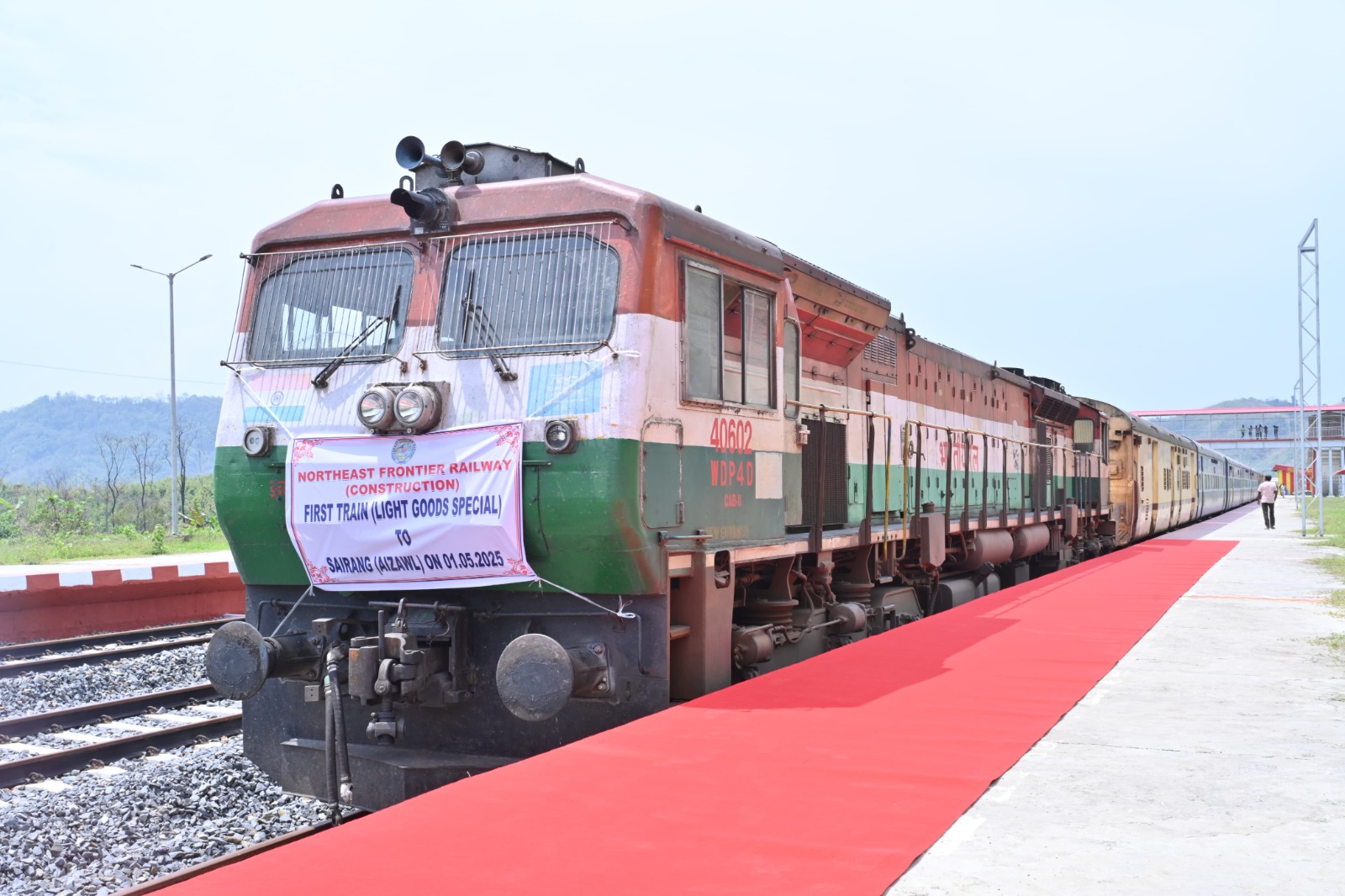The Northeast Frontier Railway (NFR) has once again demonstrated its commitment to enhancing connectivity and fostering regional development by successfully completing the inaugural trial run of the railway line to Sairang, Aizawl in Mizoram on May 1, 2025.
This landmark achievement not only signifies a major infrastructural milestone for Mizoram but also holds immense promise for the adjoining districts of Assam—particularly Hailakandi, which stands to gain considerably from this new connectivity.
The Significance of the Sairang Railway Line
The new railway line to Sairang, situated approximately 11 kilometers from Lengpui Airport (Aizawl), is poised to redefine the transportation dynamics of Mizoram and its neighboring regions. Until now, Mizoram has remained one of the few northeastern states with limited rail connectivity, posing challenges for logistics, travel, trade, and economic growth. The extension of the railway line to Sairang bridges a critical infrastructural gap and integrates the state more seamlessly with the rest of the country.
The NFR’s successful trial run is a culmination of years of planning, engineering, and political commitment. It reflects the broader national agenda of enhancing infrastructure in the Northeast, a region historically underserved in terms of transportation and logistical frameworks. For the people of Mizoram, the new railway station at Sairang opens doors to easier access to essential goods and services, increased tourism, and opportunities for economic diversification.
What This Means for Hailakandi District
For the people of Hailakandi—a district in southern Assam—the completion of the Sairang railway line is not just a development in a neighboring state. It is a transformative shift in their own regional mobility and accessibility. The geographical proximity of Hailakandi to Mizoram means that residents can now consider Lengpui Airport in Aizawl as a viable alternative to the more commonly used Silchar Airport.
Previously, Silchar Airport has served as the primary air travel hub for the residents of Hailakandi. However, it comes with logistical challenges. The journey to Silchar, though important, can be arduous due to road conditions, congestion, and limited transportation options. In contrast, the route to Sairang, and by extension Lengpui Airport, will offer a more streamlined and potentially more comfortable travel experience.
The Advantage of Lengpui Airport for Hailakandi Residents
Lengpui Airport is known for its modern infrastructure and well-managed facilities. Its proximity to the newly developed Sairang railway station (just 11 km) adds a layer of convenience that was previously unavailable to Hailakandi residents. With the railway now connecting the region directly to Sairang, a multi-modal travel route becomes available—allowing residents to combine rail and air travel efficiently.
Moreover, the cost and time efficiency of reaching Lengpui Airport from Hailakandi are likely to be more favorable compared to reaching Silchar Airport. Better road connectivity between Hailakandi and Sairang, coupled with improved public transport options, will make this route increasingly popular among the local population.
Economic and Social Implications
The improved accessibility to Aizawl via the Sairang railway line will spur socio-economic development in Hailakandi and surrounding areas. Here are several ways in which this development is expected to influence the region:
Enhanced Mobility for Education and Healthcare
Students and patients who need to travel to larger cities like Guwahati, Kolkata, or Delhi can now do so with greater ease. Faster access to Aizawl Airport means quicker transit options for those seeking specialized healthcare or higher education.
Boost to Tourism and Cultural Exchange
With easier access to Aizawl—a cultural and scenic hub in the Northeast—Hailakandi residents may find new opportunities for leisure travel and cultural exchange. Conversely, Aizawl will become more accessible to tourists from Assam, potentially boosting the tourism economy on both sides.
Growth in Trade and Commerce
The new railway line is expected to facilitate the movement of goods, particularly agricultural and forest produce, between Mizoram and Assam. Hailakandi, with its agricultural base, can benefit from easier export routes and access to new markets in Mizoram.
Job Creation and Infrastructure Development
The enhanced connectivity is likely to spur ancillary infrastructure projects such as bus terminals, taxi services, warehousing, and hospitality, leading to job creation and income generation in the region.
Interstate Relations and Cooperation
Strengthened transport links will improve collaboration between Assam and Mizoram, states that have occasionally witnessed tensions over border disputes. Increased people-to-people contact and economic interdependence can play a role in fostering peaceful coexistence and mutual development.
Environmental and Logistical Considerations
While the benefits of railway expansion are immense, it is also important to consider the environmental and logistical implications of such development. The Northeast is ecologically sensitive, and large infrastructure projects must ensure minimal disruption to the local ecosystem. The NFR has reportedly incorporated eco-friendly construction practices in the Sairang railway project, including controlled blasting techniques and slope stabilization measures to preserve biodiversity and reduce landslide risks.
Logistically, the challenge will be to maintain the new railway line efficiently, especially during the monsoon season when the region becomes prone to landslides and flooding. However, advancements in railway engineering and disaster preparedness are expected to mitigate such risks.
Strategic Importance and National Integration
From a national strategic standpoint, improved railway connectivity in Mizoram serves multiple purposes. First, it enhances the ability of the Indian government to reach remote areas quickly, which is important for both civil administration and national security. Second, it strengthens integration between the Northeast and mainland India, addressing long-standing grievances of neglect and isolation that some communities in the region have felt.
This project is also in line with India’s Act East Policy, which aims to improve connectivity between the Northeast and Southeast Asia. The new railway lines could eventually be part of broader transnational networks facilitating trade and cultural exchange between India and countries like Myanmar, Thailand, and beyond.
The Way Forward
The successful trial run to Sairang marks the beginning of a new chapter, but the work is far from over. Several steps need to be taken to ensure the success and sustainability of this new transportation corridor:
Operational Readiness: Timely completion of station infrastructure, ticketing systems, and passenger amenities at Sairang station will be critical for a smooth start to commercial operations.
Last-Mile Connectivity: Strengthening last-mile connectivity from Sairang to Aizawl city and Lengpui Airport will determine the usability of the railway for Hailakandi and other neighboring regions.
Public Awareness and Communication:
Campaigns to educate the public about new routes, travel benefits, and ticketing procedures will ensure high ridership and community support.
Intermodal Transport Integration: Coordinated transport plans that link railway services with buses, taxis, and flights will enhance the overall travel experience.
Monitoring and Feedback:
Regular assessment of the new railway line’s performance, including passenger satisfaction and logistical efficiency, will help fine-tune services and address emerging challenges.
The inauguration of the Sairang railway line is more than just an infrastructure update; it’s a symbol of progress, unity, and hope for the Northeast. For Hailakandi, it represents a golden opportunity to reconnect with new centers of growth, education, healthcare, and cultural exchange.
The availability of Lengpui Airport as an alternative to Silchar Airport—enabled by this railway link—will bring greater convenience, lower travel costs, and a stronger sense of inclusion for the residents of this border district.
In a region where geography often defines possibilities, the Sairang railway line has redefined what is possible. As trains begin to roll regularly through these new tracks, carrying passengers, goods, and aspirations, the railways will not just be moving steel and wheels—they will be carrying dreams, forging connections, and laying down the tracks of a more integrated, prosperous, and vibrant Northeast India.
( With Inputs from agencies)

